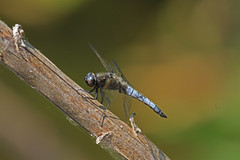The kestrel (Falco tinnunculus, Dansk: tårnfalk) is so called because it is commonly seen hovering or perched on a branch next to the road side. This phenomenon led to the perception that the kestrel was widespread but unfortunately that’s not entirely accurate. In recent decades the eradication of all species other than the desired crop from agricultural land has left these highly specialised predators with limited options for hunting their regular prey of small rodents. But motorway verges present large areas of relatively untouched grassland with a healthy supply of mice and voles so they’ve become regular hunting grounds for the kestrel.
The individual in the photographs below was perched beautifully and I’d just got it framed when an unseen dog flushed it from it’s perch:

A male kestrel taking to the air
A hunting kestrel is immediately recognisable by it’s hovering flight which provides a stable platform for the onboard weapons system of phenomenal eyesight to spot the prey and talons to despatch it and carry it away. Technically kestrels don’t hover in the way that helicopters do, they fly directly into the wind at the same speed as the wind so they don’t move forward. It’s well worth taking a close look at a ‘hovering’ kestrel through binoculars or a telescope where all the fine and rapid adjustments of the control surfaces necessary to maintain a stable position in space can be seen.
The kestrel has another trick up its sleeve which enables it to hunt small, well camouflaged, rodents scurrrying through dense undergrowth. Rodents such as voles urinate constantly and they use this to delineate their territory and to communicate information to other voles. Rodent urine contains compounds which reflect UV light and kestrels are able to see near UV and thereby track the rodents down to the end of the urine trail.
Incidentally, the reason humans can’t see UV is because it is filtered out by the lens and some people who have had their cataracts dealt with by the insertion of artificial lenses, can see UV. I found this video clip at http://birdchaser.blogspot.com. which contains some interesting information about various creatures’ use of UV light
I think the one below may be the same individual. It was perched in exactly the same spot a week later and I’ve seen a male there several times during that week. This time it was me that flushed it, but it didn’t zoom away in typical falcon fashion, it alighted on the ground between it’s tree and me and didn’t appear particularly bothered by me or the dog.

I see kestrels either just perched in a tree or hunting most days but I never get tired of photographing them, or just watching them doing what they do.






Pingback: Guns Lane Raptors | The Naturephile